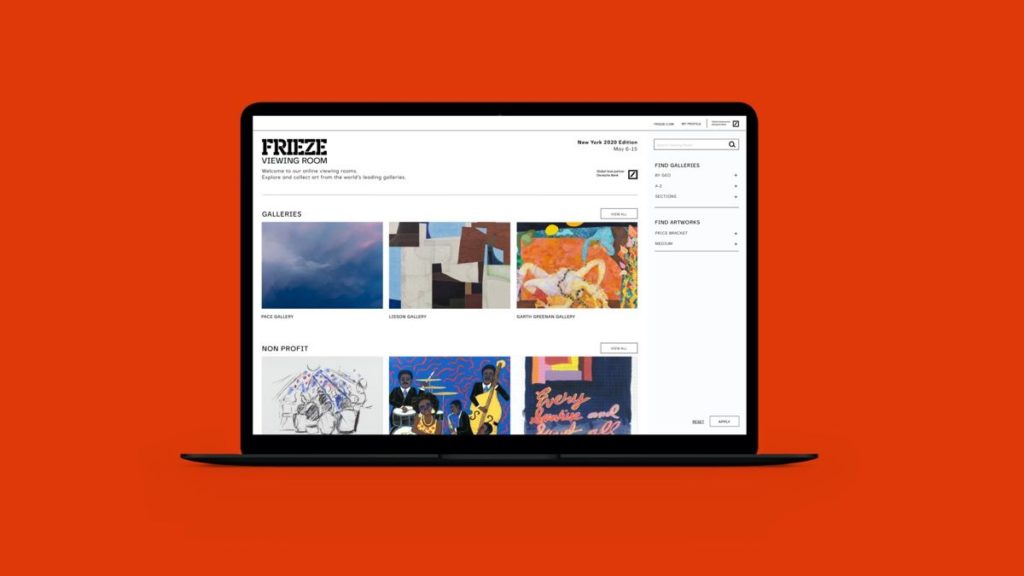Will Online Viewing Rooms Increase Price Transparency at Galleries?
Alina Cohen
Apr 15, 2020 1:01pm
 Courtesy of Frieze, Pace, Lisson Gallery, Garth Greenan Gallery and Allied Editions.
Courtesy of Frieze, Pace, Lisson Gallery, Garth Greenan Gallery and Allied Editions.
As I’ve reported on art fairs over the past few years, I’ve become accustomed to a degree of caginess about pricing. Some gallerists decline to share dollar amounts or price ranges—sometimes they won’t even distribute checklists of artworks in their booths. So I was surprised to visit Art Basel in Hong Kong’s online viewing rooms, which were open from March 18th to 25th in lieu of the yearly in-person fair (canceled due to the COVID-19 pandemic), and find specific prices or ranges listed for each of the 2,000-plus artworks on offer. Several galleries have also created new virtual platforms over the past few weeks that list prices.
Digital initiatives and price transparency go hand in hand, a number of industry professionals told me. Though overall online art sales declined by 2 percent from 2018 to 2019, according to the report “The Art Market 2020” (coinciding with a slight drop in the overall market), galleries continue to put resources and new ideas into how they present themselves digitally. As more dealers have launched online viewing rooms, they’ve also become more open to publishing information that was once closely guarded. Ultimately, galleries embrace both strategies for related reasons: to reach a larger audience, and to make sales more seamless.
Art Basel global director Marc Spiegler is careful to note that COVID-19 isn’t solely responsible for galleries and fairs overhauling their digital strategies. As he sees it, these shifts sped up as the industry adapted to its new, online-only existence. He also noted that Art Basel didn’t force participating galleries to post their exact prices—some works had price ranges spanning hundreds of thousands of dollars.
Sam Orlofsky, a director at Gagosian, is cautious about predicting how digital efforts precipitated by COVID-19 will play out in the long run. Initially, he believed our socially distanced circumstances would accelerate the art world’s embrace of digital platforms and the coinciding price transparency. Now, he said, he’s less sure “because there’s a headwind in the market. People may be willing to test this out. But if the market is in such a stark state, they may wrongly conclude it’s a failed experiment. There may be a backdraft.”
. . .
Context before commerce
Robert Dimin, a partner at Denny Dimin Gallery, also echoed artists’ concerns over price transparency. When Denny Dimin experimented with an online shop in 2016, the gallery received pushback from artists who were worried, he said, about the “excessive commercial element.” He’s realized that what’s most important to artists isn’t secrecy, but context. When the gallery launched a virtual exhibition space, it began posting essays and videos to accompany the artworks. Interested collectors are no longer browsing a catalog of objects with price tags, but learning stories about people and what they make.
Over the next few months, Gagosian is presenting an “Artist Spotlight” series online, focused on artists whose shows have closed (or not opened at all) due to COVID-19. For 48 hours, one of each selected artist’s artworks will be available, with pricing information provided. On April 8th, the program launched with Sarah Sze. Her 2020 multimedia painting Picture Perfect (Times Zero), which was priced at $275,000, sold. Interested viewers could still click the “Inquire” button to learn about other available artworks.
Orlofsky believes digital savviness will determine which small and medium-size galleries ultimately survive in an industry that increasingly favors its major players. Even working with some of the world’s most famous artists at Gagosian, he said, the artists who receive the most inquiries are those with the most successful social media. He added that he wouldn’t be surprised if, in five years, all gallery databases are accessible via their websites.
Looking forward to the return of real, multidimensional art fairs with more visitors than can reasonably fit into Zoom chats, Spiegler doesn’t anticipate any great change in how galleries will present their works. “I’m pretty certain galleries won’t start posting prices in booths,” he said.
Paris-based dealer Kamel Mennour agreed. In physical fairs, he said, “we will probably carry on as usual, with our sales team being in the booth, ready to help and inform collectors and prospects.” They will share prices when asked.
For now, Mennour is continuing to innovate in the digital realm. He has mounted an online viewing room, titled “From Home,” which situates clearly priced artworks together in a virtual gallery. By clicking on various artworks, the viewer can read a more comprehensive story about the paintings and sculptures, as well as the artists who made them.
“Today, we have found ourselves living in a world where we can either retreat in fear or connect and move forward digitally,” said Mennour. He’s chosen the latter approach.
